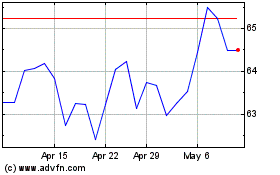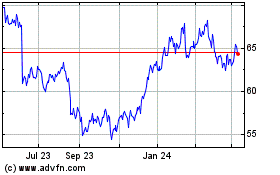Asian Shares Fall
November 23 2015 - 9:30PM
Dow Jones News
A slide in commodities prices pressured Asian resources shares
Tuesday, as investors in the region also try to navigate global
central banks' split approaches to monetary policy.
Expectations the Federal Reserve will raise interest rates at
its December meeting has strengthened the U.S. dollar, which helped
push commodities from oil to copper and gold lower overnight. Many
are priced in the currency and become more expensive to global
buyers as it strengthens. Investors are also concerned about weak
global demand and oversupply.
Australia's S&P ASX 200 fell 0.6% to 5246.90, after closing
on Monday at its highest in about a month. The materials sector
fell 1.6%.
The Nikkei Stock Average was flat, though nearing a high since
late August. Investors there await Bank of Japan minutes on
Wednesday for further insight on why the central bank has kept its
annual asset purchase target unchanged despite slowing growth.
South Korea's Kospi gained 0.3%. Hong Kong's Hang Seng Index
slipped 0.4% while the Shanghai Composite Index fell 0.2%.
"I think Asian markets are in a trading range until there's
clarity" on moves by the Fed and the European Central Bank, said
Scott Clemons, chief investment strategist at Brown Brothers
Harriman. The ECB has hinted it stands ready to unleash more
stimulus as soon as its December meeting. "Dollar strength is
likely to continue and that puts a cap on Asian markets."
The U.S. dollar has strengthened as investors wager that the Fed
will raise interest rates for the first time since June 2006 at its
December policy meeting. The euro hit a seven-month low Monday in
Asia at $1.0591 but strengthened slightly to $1.0634 early
Tuesday.
U.S. stocks slipped Monday, amid a light holiday-week trading
before the Thanksgiving holiday.
In Australia, mining shares led losses with, BHP Billiton Ltd.
down 4.3% and Rio Tinto Ltd. 2.6% lower.
The ASX rallied to its highest since late October Monday,
despite continued weakness in commodities, as investors bought bank
and consumer stocks. Analysts say demand for dividend-paying assets
after a summer selloff has driven investors toward Australian
banks, while an improving domestic economy has inspired buying
among the retailers.
Copper futures fell to their lowest levels in more than six
years overnight, weighed down by a stronger dollar and expectations
of lackluster demand. Copper for December delivery, the most
actively traded contract, closed down 1.9% at $2.0215 a pound on
the Comex division of the New York Mercantile Exchange, the lowest
level since May 2009.
Iron-ore prices sit just a whisper above their July decade low
after another sharp daily fall on Monday. Spot iron ore fell 1.8%
on Monday to $44.20 a ton, according to the Steel Index.
Nickel hit another 12 1/2-year low on Monday with the LME's
three-month nickel contract closing down 4.9% at $8,300 a metric
ton.
Brent crude oil, the global benchmark, rose 0.9% to $45.21 a
barrel. In the U.S., crude-oil futures lost 0.4% overnight to
$41.75 a barrel.
Gold prices rose 0.3% at $1,069.80 a troy ounce.
Month-to-date, the gains in Asia have been lackluster compared
with October, when much of the region bounced back sharply from a
summer selloff.
The Shanghai Composite Index is up 6.7%, the Nikkei is up 4.1%
and the S&P ASX 200 is up 0.3%. Those benchmarks were up 10.8%,
9.8% and 4.3% respectively in October.
The Hang Seng Index is near flat while South Korea's Kospi is
off 1% month-to-date.
Write to Chao Deng at Chao.Deng@wsj.com
Subscribe to WSJ: http://online.wsj.com?mod=djnwires
(END) Dow Jones Newswires
November 23, 2015 21:15 ET (02:15 GMT)
Copyright (c) 2015 Dow Jones & Company, Inc.
ASX (ASX:ASX)
Historical Stock Chart
From Mar 2024 to Apr 2024

ASX (ASX:ASX)
Historical Stock Chart
From Apr 2023 to Apr 2024
